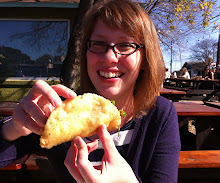On a whim last week, I picked up a small hardback at the library called "Mrs. Blackwell's Heart-of-Texas Cookbook: A Tasty Memoir of the Depression." Two minutes in, I was wholly charmed.

While only a bit of narrative (co-authored by two sisters) links a slew of resourceful farmhouse recipes for all kinds of biscuits, potato dishes and gravies, it reads pretty much as if Laura Ingalls Wilder had been bumped forward about half a century and relocated to a part of East Texas where Corsicana was considered the big city. The book is the sisters' compilation of the recipes their mother used to feed their family of 11 day in and day out, and her secret seems to lie in leaving nothing behind. With the right treatment on the stove, Mrs. Blackwell seems to have found, any old scrap can nourish — as well as earn its place in lore. John Henry Faulk, the famed Texas storyteller, opens the book with the once-widespread belief that fried chicken gizzards "had magical powers: they made boys good-looking and girls' bosoms grow spacious."
Naturally, the section on holiday turkey starts with, "First, catch the turkey."
The 1930s quaintness continues:
• A caramel dessert is listed as "Burnt Sugar Pie."
• In harder times, brownies were a great luxury with only a quarter of the chocolate in my favorite supernatural brownies recipe.
• Dessert recipes call for vanilla, cinnamon, the usual. But these were available to Depression-era families only by way of a door-to-door condiment salesman.
Also, some recipes depend not on the calibration of your oven, but the reliable heat of Texas in August. Instructions for drying peaches or apples begin this way: "Select a place on the tin roof of a barn, smokehouse, or any building which is leeward to the outhouse." At the end of the summer, this should take 10 to 14 days. And make sure to account for any rain or heavy dew.
I put one super-simple recipe to the test and baked cookies that turned out thin but chewy and not much to look at — but tasty, as the memoir's title suggests. Mrs. Blackwell's Scotch cookies seemed like the sort of plain tea snack Mrs. Piggle-Wiggle would have referred to as a "cooky," a spelling that I used to think referred to something entirely different from the Oreos and Tollhouse cookies I knew.

I think she must have meant something like this. Sometimes quaint is quite nice.
Scotch cookies
Scotch cookies
1/2 cup butter
2 cups brown sugar
2 eggs
2 cups flour
2 tsp. baking powder
1/2 tsp. salt
Cream butter and sugar. Stir in eggs, then dry ingredients. Drop on greased cookie sheet and bake in moderate oven (I took this to mean 350 degrees) for 8 to 10 minutes.


